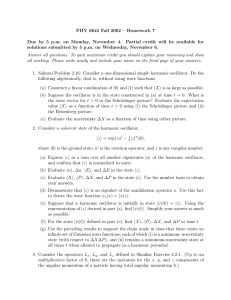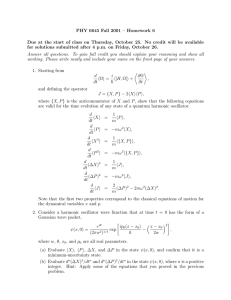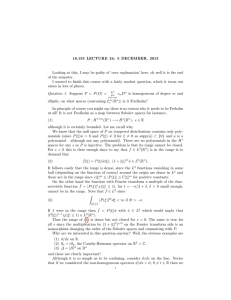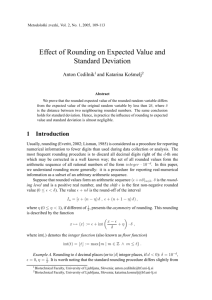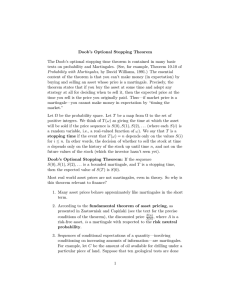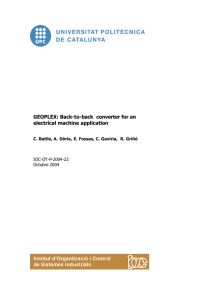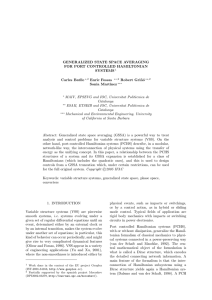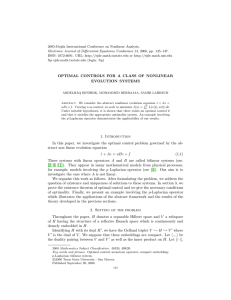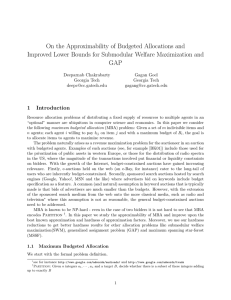Solution Set # 8 (7.1.24) Just follow the outline. (7.1.25) Set 1
advertisement
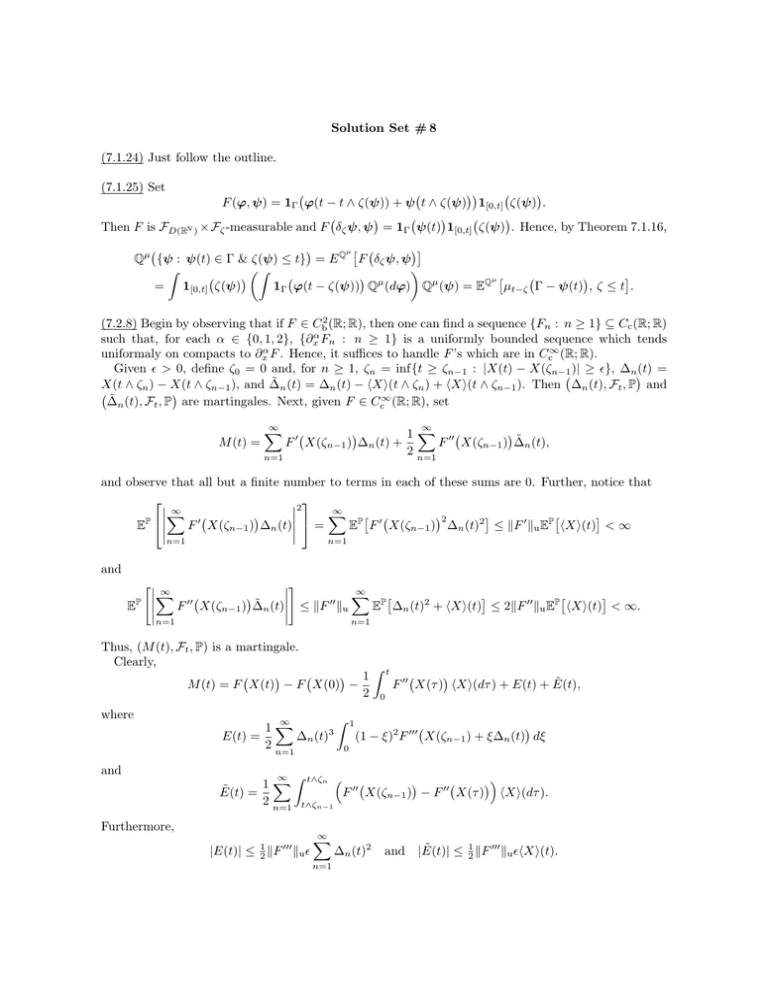
Solution Set # 8
(7.1.24) Just follow the outline.
(7.1.25) Set
F (ϕ, ψ) = 1Γ ϕ(t − t ∧ ζ(ψ)) + ψ t ∧ ζ(ψ) 1[0,t] ζ(ψ) .
Then F is FD(RN ) ×Fζ -measurable and F δζ ψ, ψ = 1Γ ψ(t) 1[0,t] ζ(ψ) . Hence, by Theorem 7.1.16,
µ
Qµ {ψ : ψ(t) ∈ Γ & ζ(ψ) ≤ t} = E Q F δζ ψ, ψ
Z
Z
µ
µ
= 1[0,t] ζ(ψ)
1Γ ϕ(t − ζ(ψ)) Q (dϕ) Qµ (ψ) = EQ µt−ζ Γ − ψ(t) , ζ ≤ t .
(7.2.8) Begin by observing that if F ∈ Cb2 (R; R), then one can find a sequence {Fn : n ≥ 1} ⊆ Cc (R; R)
such that, for each α ∈ {0, 1, 2}, {∂xα Fn : n ≥ 1} is a uniformly bounded sequence which tends
uniformaly on compacts to ∂xα F . Hence, it suffices to handle F ’s which are in Cc∞ (R; R).
Given > 0, define ζ0 = 0 and, for n ≥ 1, ζn = inf{t ≥ ζn−1 : |X(t) − X(ζn−1 )| ≥ }, ∆n(t) =
˜ n (t) = ∆n (t) − hXi(t ∧ ζn ) + hXi(t ∧ ζn−1 ). Then ∆n (t), Ft , P and
X(t ∧ ζn ) − X(t ∧ ζn−1 ), and ∆
˜ n (t), Ft , P are martingales. Next, given F ∈ Cc∞ (R; R), set
∆
∞
X
∞
1 X 00
˜ n (t),
F X(ζn−1 ) ∆n (t) +
M (t) =
F X(ζn−1 ) ∆
2
n=1
n=1
0
and observe that all but a finite number to terms in each of these sums are 0. Further, notice that
2
∞
∞
X
X
2
EP
F 0 X(ζn−1 ) ∆n (t) =
EP F 0 X(ζn−1 ) ∆n (t)2 ≤ kF 0 ku EP hXi(t) < ∞
n=1
n=1
and
#
" ∞
∞
X
X
00
˜ n (t) ≤ kF 00 ku
E F X(ζn−1 ) ∆
EP ∆n (t)2 + hXi(t) ≤ 2kF 00 ku EP hXi(t) < ∞.
P
n=1
n=1
Thus, (M (t), Ft , P) is a martingale.
Clearly,
Z
1 t 00
M (t) = F X(t) − F X(0) −
F X(τ ) hXi(dτ ) + E(t) + Ẽ(t),
2 0
where
and
Z 1
∞
1X
3
E(t) =
∆n (t)
(1 − ξ)2 F 000 X(ζn−1 ) + ξ∆n (t) dξ
2 n=1
0
∞ Z
1 X t∧ζn 00
Ẽ(t) =
F X(ζn−1 ) − F 00 X(τ ) hXi(dτ ).
2 n=1 t∧ζn−1
Furthermore,
|E(t)| ≤ 12 kF 000 ku ∞
X
n=1
∆n (t)2
and |Ẽ(t)| ≤ 12 kF 000 ku hXi(t).
Hence, if 0 ≤ s < t and A ∈ Fs , then
Z t
P
00
E F X(t) − F X(0) − 1
F
X(τ
)
hXi(dτ
),
A
2 0
Z
1 t 00
P
− E F X(s) − F X(0) −
F X(τ ) hXi(dτ ), A 2 0
P
= E E(s) + Ẽ(s) − E(t) − Ẽ(t), A ≤ kF 000 ku EP hXi(t) .
(7.2.10) By Doob’s Stopping Time Theorem, Y (t)2 − hXi(t ∧ ζ, Ft , P is a martingale, and so, by
uniqueness, hY i(t) = hXi(t ∧ ζ).
(7.2.11) Applying Exercise 7.2.9 to (λX(t), Ft , P), one sees that Eλ (t), Ft , P is a martingale. Given
this, the rest follows from the outline.
(7.2.13) The fact that X(t)Y (t) − hX, Y i, Ft , P is a martingale from
2
2
X(t) − Y (t)
X(t) + Y (t)
−
.
X(t)Y (t) =
4
4
As for the uniqueness, apply Theorem 7.1.19.
(7.2.14) Using Theorem 7.1.17, one knows that the expression in the hint is a martingale plus
f t, B(t)
2
t
Z
−2
X(τ ) ∂τ +
0
1
2∆
Z
f τ, B(τ ) dτ −
t
∂τ +
0
1
2∆
f τ, B(τ ) dτ
Z t
2
= f t, B(t) − 2
f τ, B(τ ) ∂τ + 12 ∆ f τ, B(τ ) dτ
0
Z t Z τ
0
0
0
1
−2
∂τ 0 + 2 ∆ f (τ , B(τ ) dτ
∂τ + 21 ∆ f (τ, B(τ ) dτ
0
0
Z
−
∂τ +
0
=f
2
2
t
t, B(t) −
Z
1
2∆
f τ, B(τ ) dτ
t
∂τ +
0
1
2∆
f
Z
τ, B(τ ) dτ +
t
|∇f |2 τ, B(τ ) dτ.
0
Since
Z
2
f t, B(t) −
0
is a martingale, this completes the proof.
2
t
∂τ +
1
2∆
f
2
τ, B(τ ) dτ, Ft , P
2

